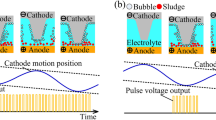Abstract
Deep narrow metal grooves have wide application prospects in the field of aeronautics and astronautics. Electrochemical machining (ECM) has a unique advantage in the fabrication of deep narrow grooves due to its advantages of no cutting heat, no cutting force, and high machining efficiency. But, there is significant stray current corrosion in the side wall of the deep narrow groove, which restricts the enhancement of the processing accuracy. In the interest of improving the processing accuracy of the deep narrow groove, the effects of compound feed and matching of pulse and oscillation (MOPAO) on the average current density distribution of the deep narrow groove side wall were studied based on finite element analysis (FEA) of the electrostatic field. The finite element simulation results show that the homogeneity of the deep narrow groove could be significantly improved with the increment of the oscillation amplitude, and the processing accuracy could be improved by prolonging the pulse turn-off time. Moreover, contrast experiments on the deep narrow groove ECM were carried out based on a self-developed ECM system. The experimental results indicate that the matching of pulse and oscillation can remarkably improve the processing accuracy, and smaller average groove width and better groove width uniformity can be obtained in comparison with the compound feed. Moreover, the maximum groove width is 2.78 mm, the minimum groove width is 2.73 mm, the length-width ratio reaches 11:1, and the depth-width ratio reaches 9:1 using the machining mode of MOPAO.
Similar content being viewed by others
References
Chang DY, Shen PC, Hung JC, Lee SJ, Tsui HP (2011) Process simulation-assisted fabricating micro-herringbone grooves for a hydrodynamic bearing in electrochemical micromachining. Mater Manuf Process 26(12):1451–1458
Liu GX, Luo HP, Zhang YJ, Qian J, Liu JW, Liu CH (2016) Pulse electrochemical machining of large lead ball nut raceway using a spherical cathode. Int J Adv Manuf Technol 85(1):191–200
Araby S, Zaied R, Haridy S, Kaytbay S (2017) Grooves into cylindrical shapes by wire electrochemical machining. Int J Adv Manuf Technol 90(1):445–455
Mansilla C, Martínez-Martínez D, Ocelík V, De Hosson JTM (2015) On the determination of local residual stress gradients by the slit milling method. J Mater Sci 50(10):3646–3655
Yan JW, Kaneko T, Uchida K, Yoshihara N, Kuriyagawa T (2010) Fabricating microgrooves with varied cross-sections by electrodischarge machining. Int J Adv Manuf Technol 50(9):991–1002
Xu K, Zeng YB, Li P, Fang XL, Zhu D (2016) Effect of wire cathode surface hydrophilia when using a travelling wire in wire electrochemical micro machining. J Mater Process Technol 235:68–74
Paczkowski T, Zdrojewski J (2017) Monitoring and control of the electrochemical machining process under the conditions of a vibrating tool electrode. J Mater Process Technol 244:204–214
Rajurkar KP, Sundaram MM, Malshe AP (2013) Review of electrochemical and electrodischarge machining. Procedia CIRP 6:13–26
Rebschläger A, Kollmannsperger R, Bähre D (2014) Video based process observations of the pulse electrochemical machining process at high current densities and small gaps. Procedia CIRP 14:418–423
Fang XL, Qu NS, Li HS, Zhu D (2013) Enhancement of insulation coating durability in electrochemical drilling. Int J Adv Manuf Technol 68(9):2005–2013
Wang DY, Zhu ZW, Wang NF, Zhu D (2016) Effects of shielding coatings on the anode shaping process during counter-rotating electrochemical machining. Chin J Mech Eng 29(5):971–976
Hung JC, Ku CY, Ger MD, Fen ZW (2016) Fabrication of an electrode insulation layer for electrochemical machining by using hot dip aluminizing and micro-arc oxidation method. Procedia CIRP 42:390–395
Lee ES, Shin TH, Kim BK, Baek SY (2010) Investigation of short pulse electrochemical machining for groove process on Ni–Ti shape memory alloy. Int J Precis Eng Manuf 11(1):113–118
Chen YL, Fang M, Jiang LJ (2017) Multiphysics simulation of the material removal process in pulse electrochemical machining (PECM). Int J Adv Manuf Technol 91(5–8):2455–2464
Yong L, Ruiqin H (2013) Micro electrochemical machining for tapered holes of fuel jet nozzles. Procedia CIRP 6:395–400
Ghoshal B, Bhattacharyya B (2015) Vibration assisted electrochemical micromachining of high aspect ratio micro features. Precis Eng 42:231–241
Wang F, Zhao JS, Lv YM, Yang ZW, Yao J, He YF, Tian ZJ (2017) Electrochemical machining of deep narrow slits on TB6 titanium alloys. Int J Adv Manuf Technol https://doi.org/10.1007/s00170-017-0392-0
Xu K, Zeng YB, Li P, Zhu D (2017) Vibration assisted wire electrochemical micro machining of array micro tools. Precis Eng 47:487–497
He HD, Zeng YB, Yao YY, Qu NS (2017) Improving machining efficiency in wire electrochemical micromachining of array microstructures using axial vibration-assisted multi-wire electrodes. J Manuf Process 25:452–460
Liu GX, Zhang YJ, Jiang SZ, Liu JW, Gyimah GK, Luo HP (2016) Investigation of pulse electrochemical sawing machining of micro-inner annular groove on metallic tube. Int J Mach Tools Manuf 102:22–34
Fang XL, Zhang PF, Zeng YB, Qu NS, Zhu D (2016) Enhancement of performance of wire electrochemical micromachining using a rotary helical electrode. J Mater Process Technol 227:129–137
Liu J, Jiang XC, Zhu D (2016) Electrochemical machining of multiple slots with low–frequency tool vibrations. Procedia CIRP 42:799–803
Zhao JS, Zhang XL, Yang ZW, Lv YM, He YF (2016) Experimental research on the optimization of precision electrochemical machining feed mode of diamond-hole grille. Int J Adv Manuf Technol https://doi.org/10.1007/s00170-016-9740-8
Lu JM, Riedl G, Kiniger B, Werner EA (2014) Three-dimensional tool design for steady-state electrochemical machining by continuous adjoint-based shape optimization. Chem Eng Sci 106:198–210
Acknowledgements
The authors would like to acknowledge the support of this research by National Natural Science Foundation of China (Grant No. 51475235), Natural Science Foundation of Jiangsu Province (Grant No. BK20161193), and Funding for Outstanding Doctoral Dissertation in NUAA (Grant No. BCXJ16-05).
Author information
Authors and Affiliations
Corresponding author
Rights and permissions
About this article
Cite this article
Feng, W., Jianshe, Z., Yanming, L. et al. Experimental research on improving accuracy of electrochemical machining of deep narrow grooves. Int J Adv Manuf Technol 96, 3217–3225 (2018). https://doi.org/10.1007/s00170-018-1700-z
Received:
Accepted:
Published:
Issue Date:
DOI: https://doi.org/10.1007/s00170-018-1700-z




